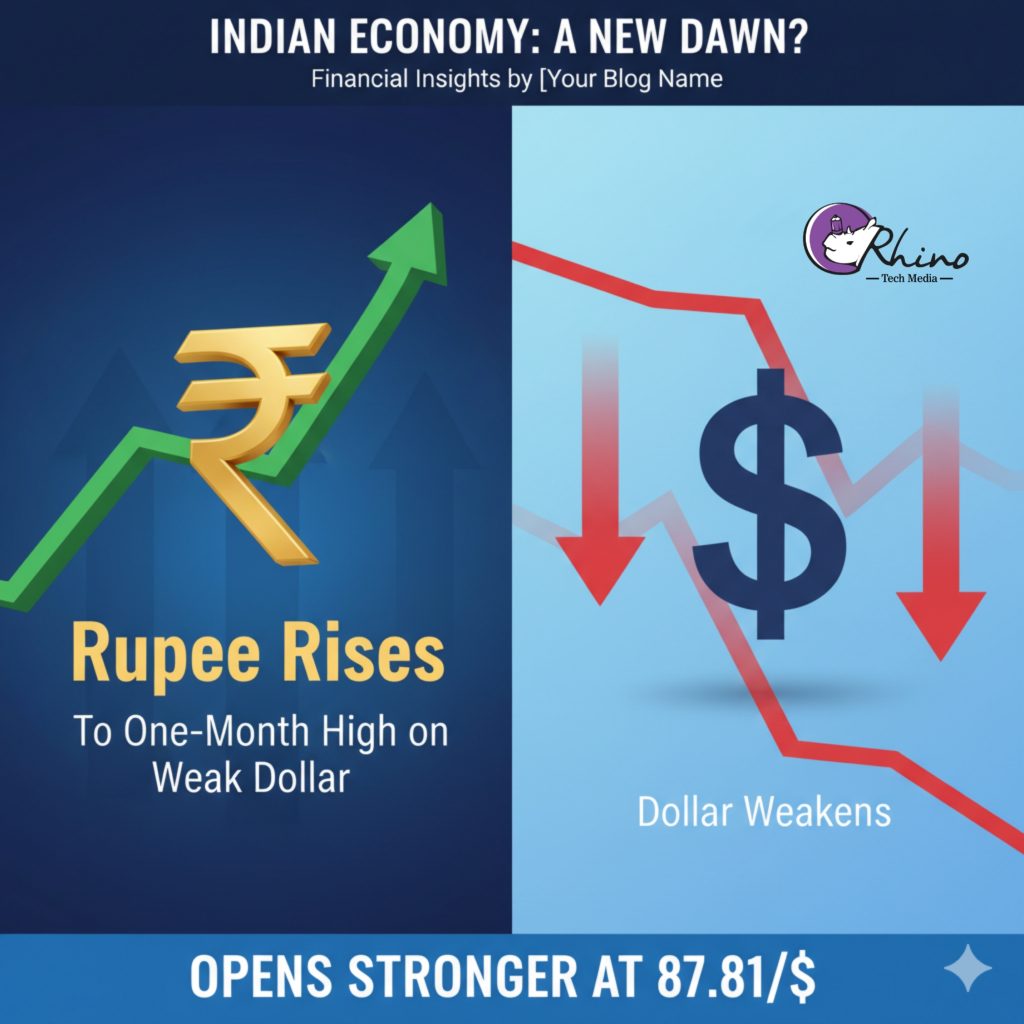The Rupee’s Resurgence: Drivers, Implications, and Outlook
On Thursday, the Indian rupee opened at ₹ 87.81 per US dollar, marking a fresh one-month high and reaffirming a short-term strengthening trend in the currency’s value. This upward move comes on the back of a weak US dollar, improved global risk appetite, and interventions by the Reserve Bank of India (RBI) to limit extreme volatility.
Context and Recent Moves
To properly assess this development, it is useful to recall the recent trajectory of the rupee. On the preceding session, the rupee appreciated sharply—its largest single-day gain in nearly four months—rising about 0.7 % to settle at ₹ 88.07 per dollar, up from around ₹ 88.8. The momentum continued into the morning of the following day, lifting the rate as far as ₹ 87.69 in early trades. Despite these gains, however, the rupee is still down about 2.61 % year-to-date relative to the dollar.
From a broader vantage point, the US dollar index (which tracks the dollar against a basket of major currencies) has faced pressures recently, due to shifting expectations on Federal Reserve policy and global macro conditions.
Key Drivers Behind the Strengthening
Several factors have combined to support the rupee’s rally:
- Weakening of the US Dollar:
The dollar’s softness has been a principal catalyst. Traders have increasingly priced in possible future rate cuts by the US Federal Reserve, reducing the greenback’s allure. In addition, global risk sentiment has improved somewhat, drawing capital flows into emerging markets and facilitating currency appreciation against the dollar. - RBI’s Controlled Interventions and Policy Signals:
The RBI appears to have acted preemptively to curb speculative pressures and maintain orderly movement in the foreign exchange market. In open markets, interventions to absorb or inject liquidity can help buffer extreme swings. Observers note that the RBI may have “ensured a higher opening for the rupee” to discourage speculative dollar buying at weaker levels. The central bank has publicly affirmed that it does not target a fixed exchange rate, but does emphasize orderly movements and preemptive measures to prevent undue disruption. - Positive Global and Domestic Cues:
The easing of broader global risk aversion, better-than-expected trade or geopolitical developments, and favourable cues in India’s trade or capital flows have lent support to the rupee. Moreover, policy discussions and trade talks that heighten optimism about external stability have a reinforcing effect. - Micro Considerations (Exporters, Importers, Hedging Behaviour):
In the current scenario, exporters might delay selling dollars to benefit from further appreciation, while importers might be more active in the spot market. The RBI’s messaging and currency guidance can influence hedging flows and speculative demand.
Implications of the Rupee’s Strength
The rupee’s strengthening—if sustained—carries a mix of benefits and challenges for different stakeholder groups:
- Exporters & Trade Competitiveness:
A stronger rupee makes Indian goods marginally costlier for foreign buyers, potentially weighing on export demand or margins. Firms heavily dependent on exports may feel pressure, especially in price-sensitive markets. - Importers & Input Costs:
Imports, including essential raw materials, capital goods, and intermediate inputs, become relatively cheaper, aiding sectors reliant on foreign inputs. This can help reduce inflationary pressures in imported goods. - Corporate Earnings & Capital Flows:
Companies servicing foreign currency debt benefit from lower rupee denominated obligations. Conversely, foreign investment returns (when converted back to rupees) may see diminished gains if the rupee strengthens further. - Monetary Policy & Inflation Dynamics:
A stronger rupee helps keep imported inflation in check, alleviating some pressure on the central bank’s inflation targets. However, the RBI must balance this against its broader macro objectives, including growth and liquidity management. - Market Sentiment & Speculative Behavior:
A clear trend of rupee strengthening may attract carry trades or speculative capital inflows, which can amplify volatility if sentiment reverses.
Risks and Caveats
While the current strengthening is encouraging, there are several caveats:
- Volatility in Dollar Dynamics:
The dollar’s trajectory is uncertain and sensitive to US economic data, Fed decisions, and global shocks. A reversal in trend could sharply weaken the rupee. - External Shocks & Global Spillovers:
Any sudden change in global risk sentiment — e.g. geopolitical tensions, commodity price shocks, or stress in major economies — can undermine local currencies rapidly. - Overreliance on Central Bank Intervention:
Too much dependence on RBI actions for stability may mask underlying vulnerabilities. Persistent intervention could strain foreign reserves or create moral hazard for market participants. - Domestic Macroeconomic Fundamentals:
India’s current account, fiscal deficit, inflation trajectory, and growth prospects will continue to be key anchors. Currency strength alone cannot offset structural weaknesses.
Outlook & Conclusion
In the near term, the rupee may consolidate in the band between ₹ 87.30 and ₹ 88.00 against the dollar, with upside contingent on further global dollar weakness and calm external markets. If anticipated USD rate cuts materialize and global liquidity remains favorable to emerging markets, further rupee appreciation is plausible. Conversely, any far more hawkish stance from the US Fed or external disruptions could reverse the trend.
Overall, the rupee’s move to a one-month high at 87.81 is an encouraging sign of resilience in India’s currency amid a weakening dollar backdrop. But for meaningful, sustained gains, alignment of global conditions, prudent RBI calibration, and strong domestic fundamentals will be essential.

